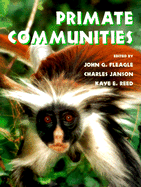Book contents
- Frontmatter
- Contents
- List of contributors
- Preface
- 1 African primate communities: Determinants of structure and threats to survival
- 2 Biomass and use of resources in south and south-east Asian primate communities
- 3 Species coexistence, distribution, and environmental determinants of neotropical primate richness: A community-level zoogeographic analysis
- 4 Primate communities: Madagascar
- 5 Primate diversity
- 6 Phylogenetic and temporal perspectives on primate ecology
- 7 Population density of primates in communities: Differences in community structure
- 8 Body mass, competition and the structure of primate communities
- 9 Convergence and divergence in primate social systems
- 10 Of mice and monkeys: Primates as predictors of mammal community richness
- 11 Comparing communities
- 12 Large-scale patterns of species richness and species range size in anthropoid primates
- 13 The recent evolutionary past of primate communities: Likely environmental impacts during the past three millennia
- 14 Resources and primate community structure
- 15 Effects of subsistence hunting and forest types on the structure of Amazonian primate communities
- 16 Spatial and temporal scales in primate community structure
- 17 Primate communities in Africa: The consequences of long-term evolution or the artifact of recent hunting?
- 18 The future of primate communities: A reflection of the present?
- 19 Concluding remarks
- Systematic index
- Subject index
13 - The recent evolutionary past of primate communities: Likely environmental impacts during the past three millennia
Published online by Cambridge University Press: 21 August 2009
- Frontmatter
- Contents
- List of contributors
- Preface
- 1 African primate communities: Determinants of structure and threats to survival
- 2 Biomass and use of resources in south and south-east Asian primate communities
- 3 Species coexistence, distribution, and environmental determinants of neotropical primate richness: A community-level zoogeographic analysis
- 4 Primate communities: Madagascar
- 5 Primate diversity
- 6 Phylogenetic and temporal perspectives on primate ecology
- 7 Population density of primates in communities: Differences in community structure
- 8 Body mass, competition and the structure of primate communities
- 9 Convergence and divergence in primate social systems
- 10 Of mice and monkeys: Primates as predictors of mammal community richness
- 11 Comparing communities
- 12 Large-scale patterns of species richness and species range size in anthropoid primates
- 13 The recent evolutionary past of primate communities: Likely environmental impacts during the past three millennia
- 14 Resources and primate community structure
- 15 Effects of subsistence hunting and forest types on the structure of Amazonian primate communities
- 16 Spatial and temporal scales in primate community structure
- 17 Primate communities in Africa: The consequences of long-term evolution or the artifact of recent hunting?
- 18 The future of primate communities: A reflection of the present?
- 19 Concluding remarks
- Systematic index
- Subject index
Summary
INTRODUCTION
Primate communities in the tropical rainforests of Africa, South America, and south-east Asia vary within and between areas in the number of species that co-exist, the biomass of the community, and the population densities of the component species. Some of this variability relates to broad ecological factors such as floral diversity and composition (which defines potential diet), and climate (which defines seasonal patterns of availability of many foods), but some is not easily related to present-day conditions and historical factors are frequently invoked (Butynski, 1990; Oates et al., 1990). ‘Deep’ evolutionary history defines the primate species assemblage of each continent and of geographically distinct regions within each continent (see Fleagle & Reed, chapter 6, this volume), but enigmas remain in understanding local patterns of distributions or differences in population densities. In this chapter we consider four kinds of historical event that may have had lasting impacts on primate communities. We restrict our considerations to the past three millennia, which represent approximately 200 to 1000 generations for most primate species.
The categories of events known, or likely, to have affected primate populations in the recent past are: climate change; human activities; outbreaks of disease; and natural disasters. In the following sections we consider whether or not evidence exists to suggest that some variations observed in present-day primate species and communities are a lasting result of these historical factors (see also Struhsaker, chapter 17, this volume). Technological development has intensified the impact of human activities on primates over the past 50 to 100 years.
- Type
- Chapter
- Information
- Primate Communities , pp. 220 - 236Publisher: Cambridge University PressPrint publication year: 1999
- 9
- Cited by



